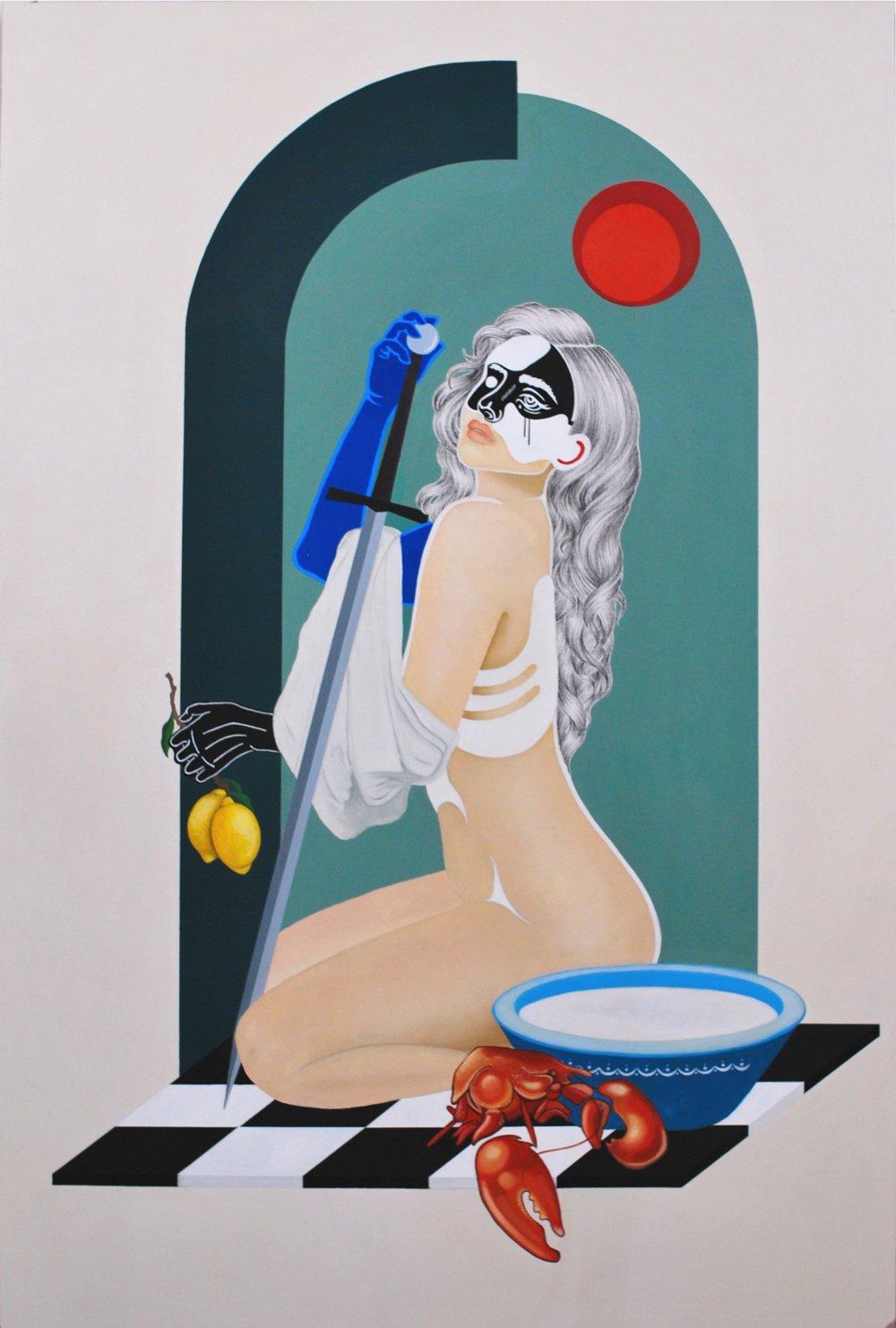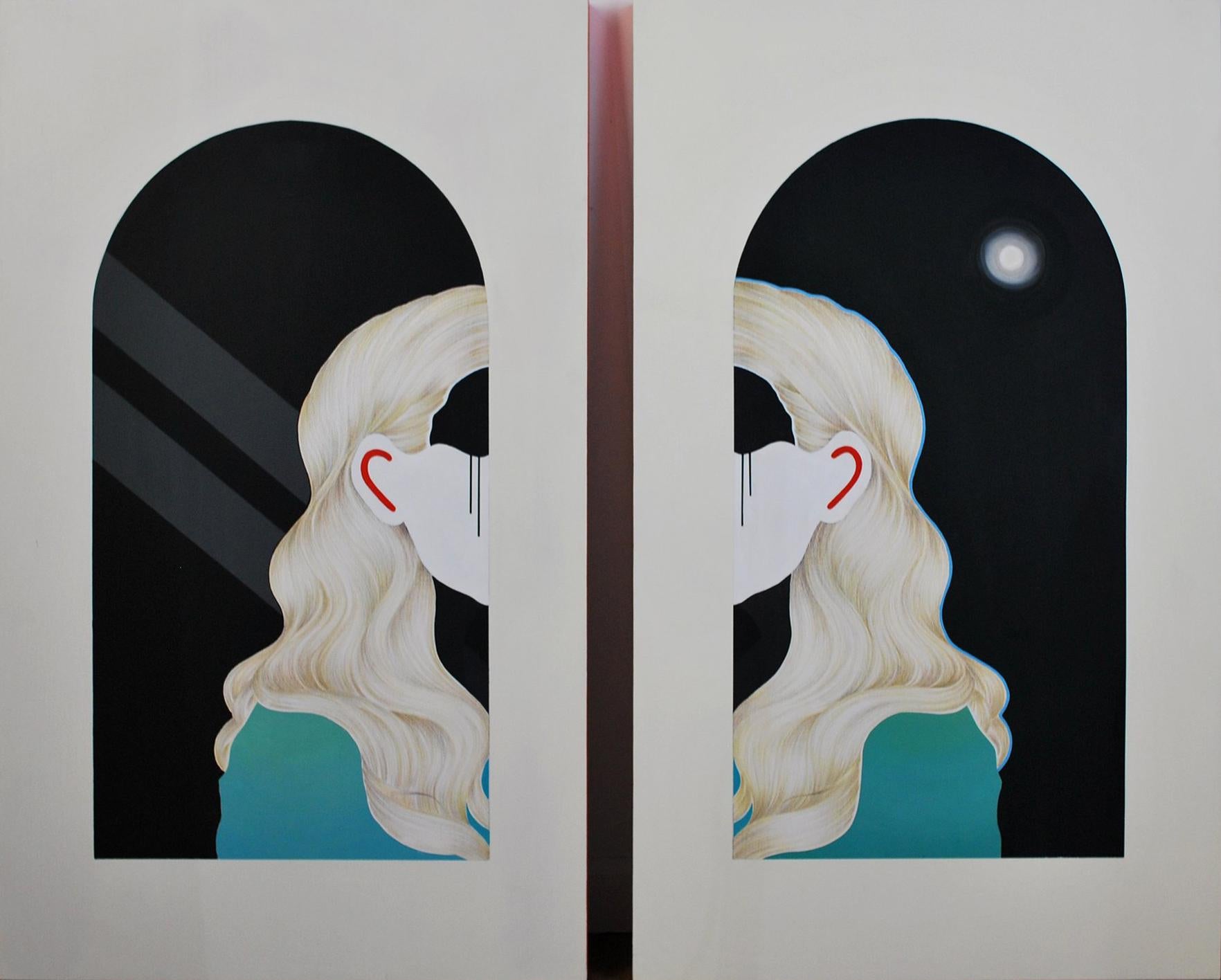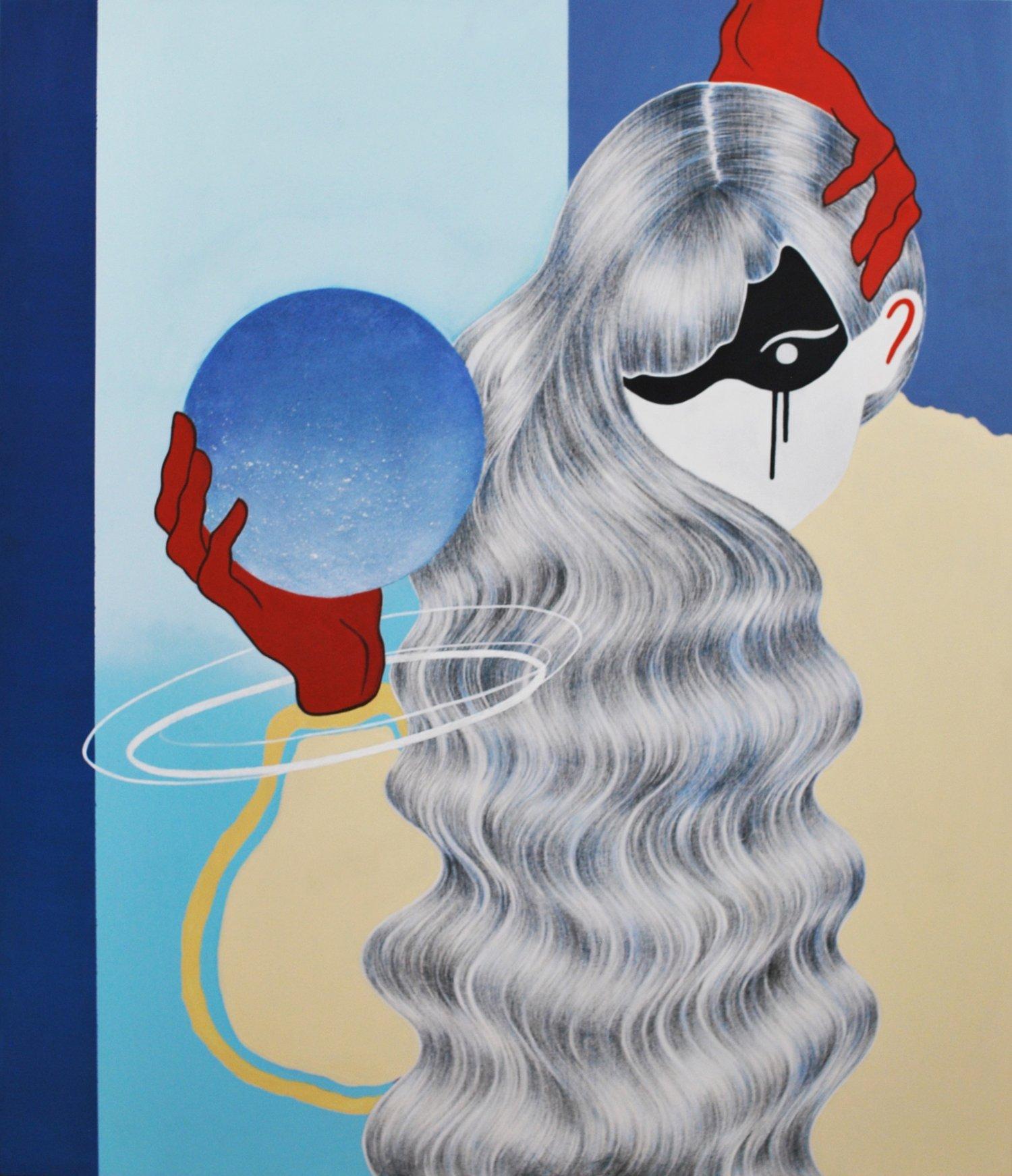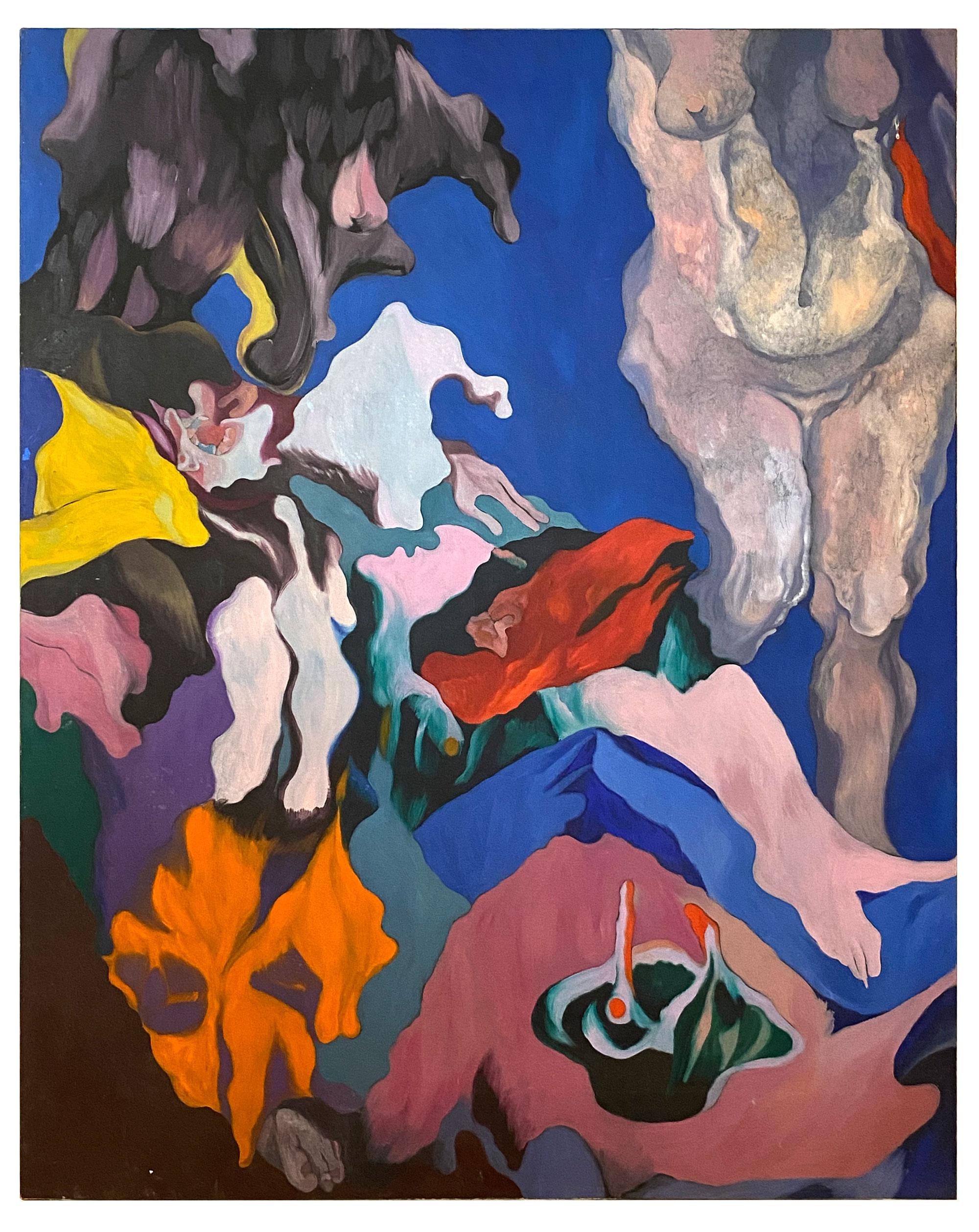Items Similar to Pavanne - 17th Century Court Dance - British exhibited Surrealist oil painting
Want more images or videos?
Request additional images or videos from the seller
1 of 14
John ArmstrongPavanne - 17th Century Court Dance - British exhibited Surrealist oil painting 1944
1944
About the Item
Painted by "Modern British" Surrealist artist John Armstrong this oil/tempera on board depicts Pavanne. The Pavanne is a 17th century Court dance. The figures bunch up rhythmically and are almost camouflaged in the darkness, almost invisible. Quite what the significance in 1944 of this historical subject is, we are not sure, but the dark overtones in the shadowy large figures with golden head and glowing hands make it quite a mystical work. It is an almost Surreal Modern British artwork and a very interesting painting. The work is painted by a very rare to find artist who is highly sought after. The painting was dirty when purchased. However since cleaning the 80 years of dirt away it has revealed the stunning figure group with their heads and golden hands and the signature and date in the lower right. A real gem of a painting has been revealed with the restoration clean. It is an important early British Surrealist work and has excellent provenance.
Signed and dated 1944 lower right.
Provenance. Alex Reid / Lefevre Galler 1945.
Condition. oil/tempera on board, 34 inches by 20 inches unframed and in good condition.
Housed in its original fine gallery frame, 43 inches by 29 inches framed and in good condition.
John Rutherford Armstrong ARA (1893-1973) was a British artist and muralist who also designed for film and theatre productions. He is most notable for the Surrealist paintings he produced. Armstrong was born in Hastings in Sussex. His father was a clergyman and Armstrong was educated at St. Paul's School in London. He studied law at St. John's College, Oxford, but switched to art and became a student at St John's Wood Art School throughout 1913 and 1914. Armstrong served with some distinction in the Royal Field Artillery in Salonika during World War One before returning briefly to complete his studies at St John's Wood Art School. After a period of some economic hardship, Armstrong began to build a career as a theatre designer in London and to gain a client base for his artworks. He received a commission to decorate a room in the Portman Square home of the art collector Samuel Courtauld, and also painted a frieze for the ballroom at 1 Kensington Palace Gardens. Armstrong held his first solo exhibition in 1928 at the Leicester Galleries in London. In 1933 he joined Unit One and displayed a set of semi-abstract paintings at their one, extended, exhibition. Throughout the 1930s Armstrong continued to work as a designer as he also continued to develop his art. He produced a number of remarkable posters for Shell and also produced four posters for the General Post Office. Armstrong designed a number of book covers for the Hogarth Press, including for William Plomer's Sado published in 1931. He worked on the first production of the ballet Façade and on a number of Alexander Korda's film productions, designing costumes for The Private Life of Henry VIII, Rembrandt and I Claudius. In 1938 Armstrong held an exhibition at the Lefevre Gallery which featured Surrealist works set in English landscapes such as Dreaming Head. Pro Patria, also from 1938, is Armstrong's comment on the Spanish Civil War. During World War Two, Armstrong worked as an official war artist undertaking short contracts for the War Artists' Advisory Committee, WAAC. In paintings such as The Elms and A Farm in Wales he recorded bomb damage to buildings such as churches and cottages. Whilst other artists, including John Piper, praised these works they were criticized by the art critic Eric Newtown in the Sunday Times as being superficial. Several works by Armstrong were included in the WAAC Britain at War exhibition held at the Museum of Modern Art in New York in May 1941. After the War, Armstrong turned away from surrealism and towards the greater use of symbols in his paintings. He produced a series of large symbolic works including The Storm for the Festival of Britain, The Battle of Propaganda, The Battle of Money and Victory, the last of which imagined the results of a nuclear attack. The painting was shown at the Royal Academy in 1958 and attracted considerable public attention. In 1955 he designed and painted the ceiling of the Council Chamber for the City Hall, Bristol and also created a light-hearted mural, The Fantastic Park, for the Royal Marsden Hospital in Surrey. Armstrong was elected an associate member of the Royal Academy in 1966 and, despite developing Parkinson's disease, he continued to paint and travel until his death in London in 1973. A memorial exhibition for Armstrong was held at the Royal Academy in 1975
- Creator:John Armstrong (1856, British)
- Creation Year:1944
- Dimensions:Height: 43 in (109.22 cm)Width: 29 in (73.66 cm)Depth: 2 in (5.08 cm)
- Medium:
- Movement & Style:
- Period:
- Condition:
- Gallery Location:London, GB
- Reference Number:1stDibs: LU853113046702
About the Seller
5.0
Platinum Seller
These expertly vetted sellers are 1stDibs' most experienced sellers and are rated highest by our customers.
1stDibs seller since 2018
398 sales on 1stDibs
Typical response time: <1 hour
- ShippingRetrieving quote...Ships From: London, United Kingdom
- Return PolicyA return for this item may be initiated within 14 days of delivery.
More From This SellerView All
- Red Idol - British 50's art abstract oil painting - Modernist COBRA - provenanceBy William GearLocated in London, GBAn original oil on canvas by the noted Scottish artist William Gear. A fabulous painting. One of his best and a seminal work which dates to 1959. Provenance. Douglas Foulis Art Galle...Category
1950s Abstract Abstract Paintings
MaterialsOil
- Death of the Young Men 1938 - British art figurative Surrealist oil paintingBy Jack SassoonLocated in London, GBAn oil on canvas painted by Jack Sassoon which was certainly a premonition of what was to come. Entitled Death of the Young Men and dated 1938, it depicts men in gas masks and a woma...Category
1930s Surrealist Figurative Paintings
MaterialsOil
- Christ Expelling Money Changers - British 30's surrealist art religious interiorBy Augustus LunnLocated in London, GBPainted by "Modern British" artist Augustus Lunn this oil/tempera on board depicts Christ Expelling the Money Changers. He exhibited widely at The Cooling Galleries and The New Engl...Category
20th Century Surrealist Figurative Paintings
MaterialsOil
- Myth III - British 1936 Modern art tempera painting Ida Graves poet familyBy Blair Hughes-StantonLocated in London, GBThis superb British 1930's modern art tempera painting is by noted interwar artist Blair Hughes-Stanton. Painted in 1936 it is part of the myth se...Category
1930s Modern Figurative Paintings
MaterialsEgg Tempera
- Onward Christian Soldiers - British Edwardian 1911 art religious oil paintingBy Frank Owen SalisburyLocated in London, GBThis striking British Edwardian religious oil painting is by noted artist Francis 'Frank' Owen Salisbury or Frank O'Salisbury as he is largely known. Painted in 1911 it is a figurative landscape of soldiers on the battlefield. The two central characters, the 'Christian Soldiers' from the early crusades have halos and ride through the chaos on white horses. Shafts on light with angels illuminate them and also a crucifix. A very powerful Edwardian religious oil painting and an excellent example of O'Salisbury's work. painted in oil and illuminated in gold leaf. Signed and dated with monogram lower right 1911. Provenance. From Castle of Park, Aberdeenshire. A version of this painting was exhibited at the Royal Academy London in 1911 entitled the Passing of War. Condition. Oil on canvas, 36 inches by 24 inches unframed and in good condition. Frame. Housed a complementary frame, 44 inches by 32 inches framed and in good condition. Francis ("Frank") Owen Salisbury (18 December 1874 – 31 August 1962) was an English artist who specialised in portraits, large canvases of historical and ceremonial events, stained glass and book illustration. In his heyday he made a fortune on both sides of the Atlantic and was known as "Britain’s Painter Laureate". His art was steadfastly conservative and he was a vitriolic critic of Modern Art – particularly of his contemporaries Picasso, Chagall and Mondrian. His father, Henry Salisbury, described himself as a "plumber, decorator and ironmonger" (his mother was Susan Hawes), yet his son Frank would become one of the greatest society artists of his generation. One of 11 children, Salisbury was such a delicate child that he was educated at home, in the main by his student teacher sister, Emilie. He had only a few weeks formal schooling and began work by repairing bicycles at his father’s Cycle Depot in Harpenden. Uncertain as to his ability to find and maintain a job, the family determined that he be apprenticed, at the age of 15, to Henry James Salisbury, his eldest brother, who managed a major stained glass company in Alma Road, St Albans. He rapidly acquired all the practical skills of a stained glass artist and exhibited exceptional skills in the painterly detail that was applied to glass before its final firing. This led to his brother sponsoring him to attend Heatherley’s School of Art three days a week to further a career in painting. He then won a scholarship to the Royal Academy Schools which he attended for five years and where he won two silver medals and two scholarships, including the Landseer scholarship which funded his to travel to Italy in 1896. In due course he would have seventy exhibits accepted for the annual Royal Academy Summer Exhibitions, from 1899 until 1943, though he was never offered membership, which reportedly disappointed him very much. In 1901 he married Alice Maude (d. 1951), daughter of C. Colmer Greenwood, with whom he had several children, including twin daughters Monica and Sylvia. His first Royal Academy exhibit was a portrait of Alice and he often painted pictures of their children. It is for portraiture that he is best known. His speed in producing portraits stemmed from his painting his own twin daughters every morning for an hour and his career began with child portraiture and his painting the Hertfordshire gentry and members of the Harpenden Methodist Church. He had a studio at his home, Sarum Chase. A providential meeting with Lord Wakefield, founder of Castrol Oils and a Methodist philanthropist, saw his introduction to society portraiture. Salisbury’s being selected to paint the Boy Cornwell in the Battle of Jutland then brought him to the notice of Royalty. Lord Wakefield then arranged for him to paint President Woodrow Wilson whilst he was in London, but Wilson departed for Paris and the opportunity was lost. It was to be John W. Davis, American Ambassador to London, who encouraged Salisbury to go to the USA; Davis had met Salisbury at art receptions and had admired his child portraits. Twenty-five members of the Royal House of Windsor sat for Salisbury and he was the first artist to paint HM Queen Elizabeth II. In 1919 he painted a mural for the Royal Exchange, London National Peace Thanksgiving Service on the steps of St Paul’s Cathedral, 6th July 1919. He painted Winston Churchill on more occasions than any other artist; the two iconic images of Churchill – The Siren Suit and Blood, Sweat and Tears are both Salisbury images. Mayoral regalia was a ready made requisite for the Salisbury style with Councillor Sam Ryder (of Ryder Cup fame) as Mayor of St Albans being the most famous of his civic images. Other significant portraits include those of Richard Burton, Andrew Carnegie (posthumous), Sir Alan Cobham, Sir Robert Ludwig Mond, Maria Montessori...Category
1910s Realist Figurative Paintings
MaterialsOil
- Children in School Room Interior - British Victorian Newlyn School oil paintingLocated in London, GBThis superb, large British Victorian oil painting is by noted Newlyn and Menton artist Arthur Alfred Burrington. It was painted circa 1890 when Burrington was most likely in Newlyn, ...Category
1890s Victorian Interior Paintings
MaterialsOil
You May Also Like
- In the garden. 1970s Cardboard, tempera, 59x59 cmBy Vladimir GlushenkovLocated in Riga, LVIn the garden. 1970s Cardboard, tempera, 59x59 cm Vladimir Borisovich Glushenkov (May 21, 1948, Riga - December 26, 2009, Riga.) - painter, graphic artist, poet, translator. Born i...Category
1970s Surrealist Figurative Paintings
MaterialsMixed Media, Tempera, Cardboard
- Colorful Surreal Abstract Expressionist Painting of a Macabre Group of ClownsLocated in Houston, TXSurreal abstract expressionist painting of a group of clowns in the style of Belgian painter James Ensor. Combining the macabre with the playful, the work features distorted clowns a...Category
1990s Surrealist Figurative Paintings
MaterialsTempera
- Sour CreamLocated in Nashville, TNAlison Underwood's work evokes various emotions of desires as her artwork proves to display the ideas of temptation and anticipation. These profound feelings are demonstrated in the ...Category
2010s Surrealist Figurative Paintings
MaterialsOil Crayon, Oil, Acrylic
- Before / After (diptych)Located in Nashville, TNAlison Underwood's work evokes various emotions of desires as her artwork proves to display the ideas of temptation and anticipation. These profound feelings are demonstrated in the ...Category
2010s Surrealist Abstract Paintings
MaterialsOil, Acrylic, Oil Crayon
- Past Perfect Future TenseLocated in Nashville, TNAlison Underwood's work evokes various emotions of desires as her artwork proves to display the ideas of temptation and anticipation. These profound feelings are demonstrated in the ...Category
2010s Surrealist Abstract Paintings
MaterialsOil, Acrylic, Oil Crayon
- Large Mid-20th Century Surrealist Painting by Nicholas OrsiniLocated in Stone Mountain, GA"Stunning surrealist painting by Mid-20th Century artist Nicholas Orsini. Both figural and botanic in an array of deep, saturated hues. Oil on stretche...Category
Mid-20th Century Surrealist Abstract Paintings
MaterialsOil




